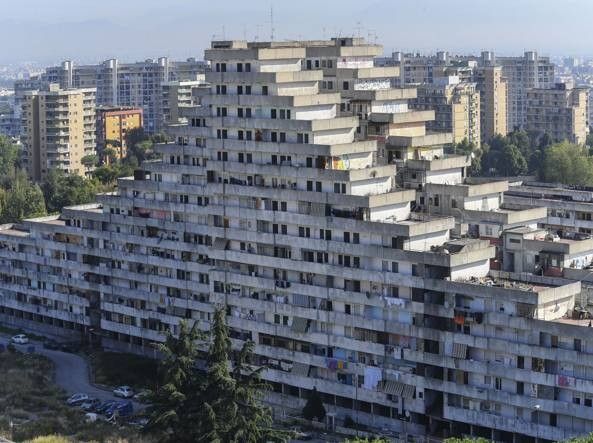Known for being the setting for hit TV series and film Gomorrah, the Le Vele towers were a symbol of organized crime and poverty – until the residents decided to take matters into their own hands.
Until recently, Le Vele was both the location for Western Europe’s biggest international arms and drugs supermarket as well as the location for Gomorrah, a hit Italian movie and TV series.
In 2004, these tower blocks became famous all over the country when a bloody feud broke out between the Di Laura Camorra clan & the Secessionists, a splinter faction. They fought to control the lucrative drug trade industry for over a year. During the peak of the feud, more than one murder took place every day with more syringes being found per sq mi. in Northern Naples compared to the rest of Italy.
However, authorities are finally ready to completely demolish the tower blocks now. The fight to do so was surprisingly spearheaded by the local residents. For them, many of whom have now moved into newly-built apartments, this demolition is the culmination of a tiresome struggle against architects, politicians, and the fearsome stigma of being the setting for Gomorrah, which made the buildings a representation of the criminality and social ills prevalent in Italy.
Demolition Represents Failure
This demolition also represents the failure of the country’s social housing dream. Built by Franz Salvo, these towers were supposed to completely replace the squalor and slums of the city center. There were 7 blocks and each was supposed to house around 210 – 240 families, similar to traditional neighborhoods. A central walkway connecting the towers was also planned for fostering better community relations.
However, nothing worked the way it was supposed to. Eventually, compromises had to be made and funds siphoned off by corrupt elements. The corridors happened to be much narrower, the blocks much closer. The proposed social spaces and transport links were non-existent as well. All it did was isolate hundreds of destitute families in an enormous concrete slum without any access to proper work.
The blocks weren’t finished completely. Eventually, hundreds of homeless refugees started squatting all over the apartments when they fled an earthquake in 1980.
People who grew up in Le Vele still remember their unconventional childhoods – playing games using rubbish bags in empty garages, corridors, and stairwells while navigating drug users who queued up in basements for collecting drugs. Children had to make sure they didn’t touch the needles discarded by the addicts.
Living with drug dealers and addicts
However, the residents also learned to exist peacefully with drug dealers and drug addicts. They realized that the Camorra would leave them alone, so long as they minded their own business. Additionally, they were also prepared to deliver much-needed food packages that provided relief to the residents.
The residents had a complicated relationship with the gangs that ran Le Vele. The clan wars took the lives of many residents in the buildings. However, as unemployment rates hit 70%, people had no other way of making a living apart from participating in the country’s black market.
In the beginning, the residents tried to stay put inside their flats and formed a large support group for this purpose. They desperately wanted a place they could call home and were prepared to fight for this. However, they soon realized that their home was really just a crumbling, squalid, damp structure that was infested by crime and abandoned by the authorities. They diverted their focus to campaigning for the construction of new apartments instead.
Residents understood that no amount of money or refurbishment plans could restore Le Vele. The buildings were plagued with troubles right from the start. The walls only had a thickness of around 12 cm, meaning that condensation would give rise to thick mold layers inside these flats.
Progress, but still 20 more years to wait
Back in 1991, Vittorio Passeggio confronted the then Italian President Francesco Cossiga, asking him to intervene and provide them with an acceptable solution. This meeting eventually helped the creation of an agreement that sought to develop several apartment blocks. However, the entire process of recognizing all 926 families & proceeding with the demolitions would require another 20 years of sit-ins, protests, and abysmal bureaucracy. Additionally, there were several architects who held that these buildings were a unique representation of the modernism movement. They argued for the protection of these buildings from demolition.
The company that was awarded the contract for maintaining the blocks didn’t do any work at all. It was eventually held guilty of embezzling state funds.
Finally, the Comitato (an association formed by the residents) assumed the duties of administration for the buildings. The residents were documented, conflicts between them resolved, and the unemployed were given new opportunities. The Comitato played a crucial role in resolving issues that kept cropping up at the buildings.
Then Gomorrah burst onto the scene.
While the Comitato was less than enthusiastic about allowing the series to be filmed here, they couldn’t just pass up on this opportunity. The maintenance of the building was paid for to some extent by the production studio that also employed the residents as cleaners, extras, and runners. The Comitato also utilized the money from Gomorrah for blocking lift shaft entrances and for purchasing and installing strip lighting.
The latest announcement means that Gomorrah will soon need to move to another place for filming the show. Every family has moved into newly-constructed apartments that were designed by the Comitato, ensuring that previous mistakes were not repeated again. One tower is set to be preserved though. It will serve as either an office or a museum.
Many residents have mixed feelings about the move away from Le Vele. While they are grateful for the better lifestyle, and cleaner and safer homes, they do miss their community that had been such a strong part of their life previously.
The Comitato is now focused on enhancing the existing urban environment to the next level. The Restart Scampia program has already won ample funding to launch a campaign for improved student accommodation, schools, sports facilities, cycle routes, and transport links.









